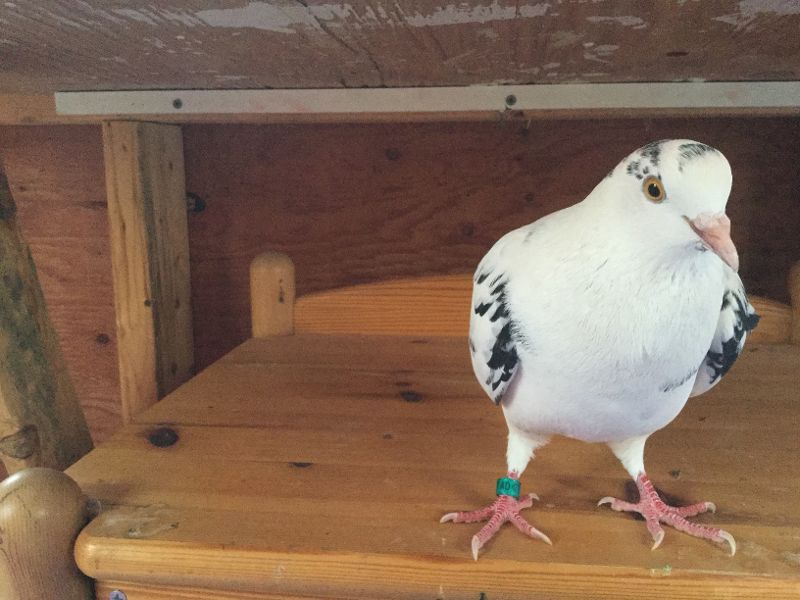Domestic Pigeons: The Hidden Avian Welfare Issue
Reprinted from The Official NEEWSLetter of Foster Parrots & The New England Exotic Wildlife Sanctuary
By Michele Nash
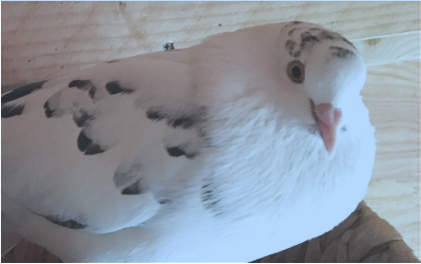
Kahuna
Sometimes animals enter our lives quite unplanned, and most often after they have already endured their own inauspicious and circuitous path before coming under our care. If someone had told me I’d be spending three solid days and two hundred dollars renovating a shed to build a large aviary for a pigeon I’d have said they were crazy. But when Kahuna arrived at the New England Exotic Wildlife Sanctuary, he, as they say, had me at “Coo”. Apparently still quite young, he had been found on a street in Providence. Under the care of the NEEWS he was vetted and de-loused. Within just a few weeks he had increased impressively in size and was utterly handsome! But without other pigeons of his variety at the sanctuary he was without community. After months of making excuses why I should not take in the lone bird with no friends and a feisty attitude, I brought him home from the sanctuary.
Kahuna is a homing pigeon, or a ‘Homer’ in pigeon racing parlance. His band could be traced to a pigeon club in Massachusetts, but we have found that breeders generally do not welcome the return of pigeons who fail to fly home. Not willing to invest resources or support the genetics of pigeons regarded as “damaged goods”, some pigeon breeders will euthanize these undesirable birds.
Homing pigeons bond strongly and mate for life. So strong is their reproductive drive and their desire to get back to their mates that they are, in fact, seen as a symbol of fidelity, love and home. This propensity for bonding has been exploited to the point of creating a sport that is global in scope and can be extremely lucrative for breeders of some of the world’s most acclaimed racing birds. One very successful method for training homing pigeons for lives as racers is referred to as “widowhood”. Once a homing pigeon has been mated and produced offspring, these birds are allowed access to their mates and their babies only upon returning from their race. This creates the sense of urgency needed to cultivate a winner. Some racing pigeons are simply shown their mates in the presence of another bird within their nest box before being taken away to race and the lasting image of that drives them to fly faster to deal with the interloper when they get back home. While methods like these create “money-makers” for hobbiests, it’s yet another example of human use of animals for utilitarian purposes without consideration for the impact on the animal. Pigeons bond for life and sometimes do form lifelong bonds even with same-sex partners, suggesting that bonding is rooted in emotional attachment, not just reproduction. And of course, we cannot ignore the risks to the lives and safety of the birds. Predation is a constant threat, and factors like weather systems, accidents, hunger, dehydration and exhaustion result in the untold numbers of injured and lost pigeons that fill humane shelters from coast to coast every year.
Pigeons are not widely regarded as “companion animals”, but the fact is that these birds can make wonderful pets. They are intelligent, affectionate and interactive. Their soft coos are infinitely more pleasant to listen to then the calls of the average parrot! Most of all, the need for homes for these birds is enormous. Pigeons bred for racing or for dramatic releases at events like weddings do not have the ability to survive in the wild without assistance from people to provide food, shelter and protection from predators. They are not “wild animals”.
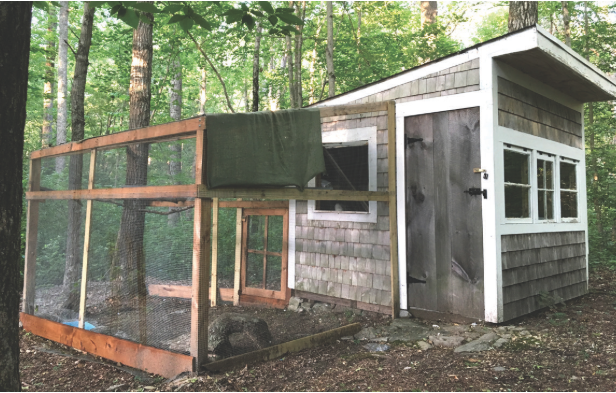
Happy new pigeon home
Kahuna happily came home with me and together (with maybe a teeny bit of help from my husband) we converted our shed into a very impressive pigeon coop. Kahuna was instantly at home, but he was still lonely. This led me to the MSPCA in Boston where “Pudge” had been waiting almost 3 months for adoption. Upon first seeing her in her cage at the shelter I was dumbstruck. The picture online did not properly convey her size at all. She was enormous, at least twice the size of Kahuna. And she was beautiful! Pure white and sleek as a sea otter with a cranium shaped like a beluga whale, she sat there placidly and royally, as if waiting for her prince to arrive.
Pudge is a King Pigeon, I soon learned, and according to veteran pigeon rescuer Elizabeth Young from Palomacy Pigeon & Dove Rescue in San Francisco, CA., these impressive birds are the “masters of the leisure arts”, a large docile breed known to produce the young squab seen on many restaurant menus. Like Kahuna, Pudge had no ability to survive in the wild. Had she not been found and brought to the MSPCA she would have perished.
I arrived home with Pudge, and since it was approaching dusk, I thought I would allow just a brief introduction through the bars of her carrier and take her inside with me for the night. This was not to be. From first sight, Kahuna stopped doing his perpetual figure 8’s and constant cooing and stared, and stared, with what looked like awe. I let Pudge out of her carrier and she lifted off, albeit like a Flying Fortress heavy bomber, whereby she alighted immediately on a roost in the outdoor aviary- Kahuna following fast like a nimble and quick F-18 in comparison. A few chortles later by Kahuna, and they were enjoying seed on the ground together. Within just a couple days they were inseparable, happily lazing about, engaging in friendly beak wrestling and canoodling in the basket that Kahuna had claimed as their nest. The rescue of one lucky pigeon had resulted in the rescue of two, and also the beginning of my advocacy for these remarkably intelligent and social birds.

Pudge & Kahuna
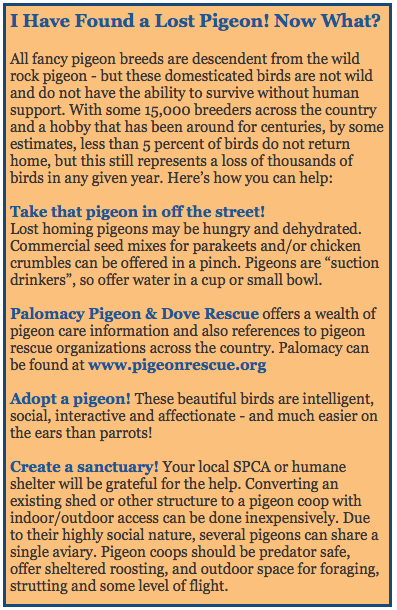
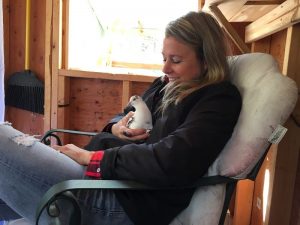 Michele Nash: After exiting stage left from the workaday world over a year ago, I have suddenly found myself with that very precious commodity…TIME. I am now happily able to devote myself to the causes that had tugged at my heart strings for years. The more involved I’ve become caring for different species, as well as our own, the more I’ve realized that loneliness, and thus neglect, is a pervasive condition shared amongst all. It is this condition which inspires me every day to get out the door and spend as much time as I can to alleviate it for as many as I can come in contact with. I’ve never been happier, the rewards have never been greater, and the people and animals I’ve met never more inspirational..
Michele Nash: After exiting stage left from the workaday world over a year ago, I have suddenly found myself with that very precious commodity…TIME. I am now happily able to devote myself to the causes that had tugged at my heart strings for years. The more involved I’ve become caring for different species, as well as our own, the more I’ve realized that loneliness, and thus neglect, is a pervasive condition shared amongst all. It is this condition which inspires me every day to get out the door and spend as much time as I can to alleviate it for as many as I can come in contact with. I’ve never been happier, the rewards have never been greater, and the people and animals I’ve met never more inspirational..
Editor’s Note: Kahuna is actually a type of pigeon called a Roller, not a Homer. (Learn more at Violet (Or What’s Wrong with Roller Pigeons?)
